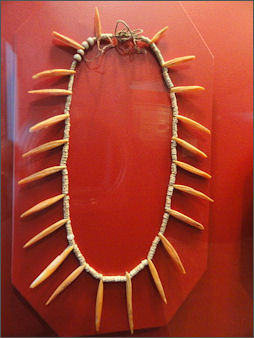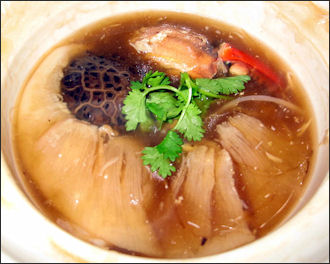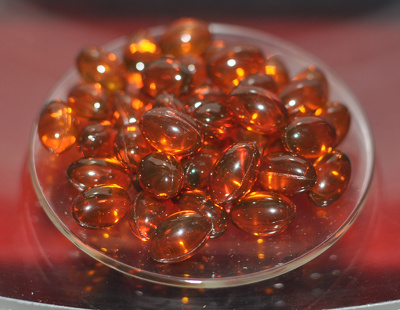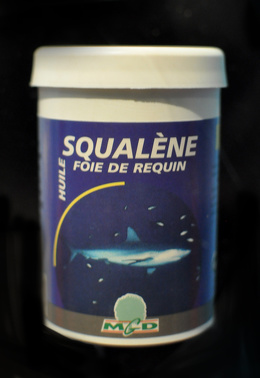Home | Category: Humans, Sharks and Shark Attacks
SHARK PRODUCTS AND MEAT

Necklace made with shark vertebrae Shark skins are tanned to produce exotic high-quality leather are made into wallets, belts, luggage, purses, watchbands and sharkskin boots. Shark liver oil is used in the tanning industries and in the manufacture of lubricants, cosmetics, vitamins and pharmaceutical products. Shark cartilage is used in the manufacture of fishmeal.
The jaws of large sharks are sold for thousands of dollars. Sharkskin, made from the same material as shark teeth, was used at one time by cabinet makers as sandpaper.
Shark meat keeps well but is full of cartilage and has strong aroma that many people find unappealing. It is boneless and mild tasting and sometimes still quivers from muscles contraction six hours after the shark has been removed from the sea. In the old days what shark meat was often pawned off as scallops and "steakfish" in restaurants. Shark meat was and still is one of the most common ingredients in fish and chips.
The taste of shark meat varies from species to species. Tiger shark meat is said to tough and not so good. Mako is considered the tastiest shark. Some sharks have high levels of mercury. The strong smell of shark meat is caused by relatively large concentrations of urea, a component of urine. In Japan, where shark meat is not popular, the meat is dried saturated with soy sauce and miso paste to get rid of the strong smell and sold as a snack that can be consumed with sake.
According to the FAO, half the sharks landed in China are processed into fillets and fish balls for local consumption. There are factories in Fujian Province that extract fish liver oil and make drugs with it. Shark liver contains vitamin A, vitamin D, DHA and EPA. Dogfish alkene is used to make skin creams and antifungals.
Shark livers, which are so massive they take up a forth of the fish's weight, used to be the world's main source of Vitamin A. The demand for Vitamin A drove up the price of shark livers from $11 a metric ton in 1938 to $1,653 in 1942. Up until a synthetic version of Vitamin A was synthesized in 1950 shark fisherman were rich men.
HISTORY OF HUMANS AND SHARKS: ANCIENT PEOPLE, ART AND WRITERS ioa.factsanddetails.com; ENDANGERED SHARKS AND COMMERCIAL FISHING ioa.factsanddetails.com; SHARK FIN SOUP AND TRYING TO STOP CONSUMPTION OF IT ioa.factsanddetails.com; SHARK TOURISM AND SWIMMING WITH SHARKS ioa.factsanddetails.com ;
Websites and Resources: Shark Foundation shark.swiss ; International Shark Attack Files, Florida Museum of Natural History, University of Florida floridamuseum.ufl.edu/shark-attacks ; Animal Diversity Web (ADW) animaldiversity.org; National Oceanic and Atmospheric Administration (NOAA) noaa.gov; Fishbase fishbase.se ; Encyclopedia of Life eol.org ; Smithsonian Oceans Portal ocean.si.edu/ocean-life-ecosystems ; Woods Hole Oceanographic Institute whoi.edu ; Cousteau Society cousteau.org ; Monterey Bay Aquarium montereybayaquarium.org ; MarineBio marinebio.org/oceans/creatures
Shark Liver Oil — a Key Ingredient in the Beauty Industry
Sharks are also targeted for their liver oil, a source of squalene. Lucy Ellis wrote in in Earth.org: Squalene is a natural organic compound with moisturising and restorative properties. This compound is naturally produced by the sebaceous oil glands in our skin. However, as we get older, the production of natural squalene decreases so people have started resorting to other sources such as shark liver oil to keep skin looking healthy and improve skin texture. [Source: Lucy Ellis. Earth.org, July 1, 2022]
Shark liver oil is a major source of squalene and it is commonly used in cosmetics such as anti-aging cream, suncream, lipsticks, lip balm, foundation and eye make-up. Another variation is squalane, which is derived from the hydrogenation of squalene. Squalane offers the same properties as squalene but it has a much longer shelf life so it is more commonly used in personal care products. But it is important to note that both squalene and squalane can come from sharks. Although squalene can also be extracted from plants such as sugar cane, olives and fruits, it is 30 percent more expensive to harvest, which makes shark squalene a much more favourable commodity.
Bloom Association, an ocean conservancy and advocacy organisation in Hong Kong, claims that 90 percent of all shark liver oil production is sold to the cosmetic industry. As it can take up to 3,000 sharks to produce 1 tonne of squalene, it is not surprising that 3 million sharks are killed every year to serve this industry alone.
In some cases a shark’s live is cut out and the shark is dumped back in the sea — a practice called livering. Livering is a cruel and inhumane process akin to shark finning. Sharks subjected to livering suffer a slow and painful death. A shark’s liver can account for up to 25 percent of its body weight, making it the biggest organ in their body. Unlike other fish, sharks don’t have swim bladders, so their large oily livers help to control their buoyancy. In general, deeper water sharks have a higher content of squalene and are therefore primary targets for the beauty industry. Unfortunately, now more than 60 species of shark are targeted for their livers and 26 of those are now listed as vulnerable to extinction by the International Union for Conservation of Nature (IUCN).
The beauty industry is highly unregulated so cosmetic companies and brands have no legal obligation to let consumers know the source of squalene used. In 2014, Bloom Association tested 62 moisturising creams, whose list of ingredients mentioned squalene, in the US, Europe, Asia. The testing revealed that 1 out of 5 creams tested positive for shark squalene.
Shark Fin Soup
Shark fin soup popular in southern China, Singapore, Hong Kong and in Chinese and Asian communities all over the world. It has a glutinous texture and is made by boiling shark fins with vinegar, starch and spices. Quality shark fin soup contains mushrooms, dried ham, other seafood, clear chicken stock and is simmered for up to eight hours.

Shark fin stew Once a dish for Ming Dynasty emperors, shark fin soup is considered a must-have at Chinese wedding banquets and corporate dinners and is often served at 80th birthday celebrations. A Chinese banquet is not regarded as complete without shark fin soup. It has traditionally been served to impress guests. At wedding banquets it is seen as a sign of appreciation from the host to guests. A shark fin wholesaler in Singapore told Reuter, "Shark fin has been a traditional food for the Chinese for thousands of years. There is something missing if you go to a wedding dinner with no shark's fin."
China consumes more shark fin than any other country in the world, according to the campaign group WildAid. Shark fin soup is also served at business lunches and dinners to celebrate a new deal. One Hong Kong banker told the New York Times, “This is a very basic dish for business dinners in Hong Kong. If you don’t order that, you will lose face.”
Shark fin soup was once regarded as a delicacy that only the rich could afford. Four hundred years ago shark fin soup was served at banquets for emperors and wealthy nobles and merchants. Emperors reportedly fancied it because it was exotic and difficult to prepare and they liked the taste. In recent years as China has become wealthy, more and more people can afford it. Now there are many well-off middle class people that can afford it and there numbers are increasing all the time.
See Separate Article SHARK FIN SOUP AND TRYING TO STOP CONSUMPTION OF IT ioa.factsanddetails.com
Sharks, Disease and Cancer
Sharks almost never get cancer or catch diseases. They have been injected with enough cancer causing and disease-causing agents to wipe out a small city yet they suffer no ill affects. As of the the mid 1990s only six cases of sharks with tumors had ever been reported and only two of the tumors were malignant. One explanation for their resilience is the fact that sharks were one of the first creatures to develop an immune system and they have had 400 million years to build up an effective resistance to a host of diseases.
Scientist are now exploring the use of shark cartilage and a coenzyme produced by sharks called Q10 as a cancer treatment. In 1992, it was discovered that some species of shark have a natural steroid in their liver that has proved effective fighting cancer by cutting off the flow of blood to some tumors. For a while there the Cubans were big promoters of shark cartilage cures and were reports of company in Costa Rica that turned the cartilage of 235,000 sharks into pills every month.
Shark cartilage has been used in making artificial skin. Shark corneas have been used experimentally in human transplants and studies have show that shark liver oil stimulates disease-fighting white blood cell production and stops hemorrhoids.
Shark Cartilage and Cancer
Shark cartilage is a food or dietary supplement. It is sometimes used by people as an alternative cancer treatment. There is not enough reliable evidence that it works as a cure for cancer. According to Cancer Research UK: Shark cartilage comes from spiny dogfish sharks and hammerhead sharks. Claims that shark cartilage can treat cancer are not backed up by research. Using shark cartilage as an alternative to conventional cancer treatment can be very harmful to your health. Shark cartilage can be quite expensive. Capsules sold over the internet can cost from around £20 for a box of 100 capsules. [Source: Cancer Research UK]
Cartilage is a tough, flexible tissue found in the body and has no blood supply. Shark cartilage comes from spiny dogfish sharks and hammerhead sharks. It is available as a powder or liquid which you can buy as a food or dietary supplement. There are several different brand names for shark cartilage.
It was once thought that sharks can't get cancer. But this is not true. Sharks can get cancer. There is no scientific evidence that shark cartilage can control or cure cancer. Some people use shark cartilage as an alternative cancer therapy. This means that they use it instead of conventional cancer treatment such as chemotherapy, targeted drugs or radiotherapy. This can be very harmful to your health and we do not recommend that you do this.
Shark cartilage comes in various forms. The most common type is capsules that you swallow. You can also take it as: a) a powder or liquid that you swallow; B) an enema (a liquid into the back passage); and C) an injection under the skin. Most researchers agree that the protein molecules in shark cartilage powders are too big for the digestive system to absorb. So shark cartilage that you swallow is not likely to be absorbed into the body.
In the UK, shark cartilage is sold as a food supplement and not a drug. You can buy it over the counter in many health food shops. The USA’s Federal Trade Commission found that many over the counter products don’t actually contain much shark cartilage. Unfortunately, we don’t know how much shark cartilage is in the products available in the UK. There is no scientifically proven recommended dose of shark cartilage. Some commercial suppliers suggest 70 grams per day. But shark cartilage contains calcium salts, and some doctors are worried this would mean taking in too much calcium. This could cause serious health problems.
Side effects: We know from research that shark cartilage can often cause changes in the way you taste things. Other rare side effects include: feeling and being sick, itching, diarrhea, constipation, indigestion, dizziness, swelling of the hands and feet due to fluid build up, tiredness, low blood pressure, high, blood calcium levels, loss of appetite, change in blood sugar levels, These effects can be serious. Doctors recommend that people with liver disease should not take shark cartilage.
Researchers have been interested in cartilage as a potential treatment for cancer because cartilage doesn’t contain any blood vessels. Cancers develop blood vessels to supply them with food and oxygen and help them to grow. Some laboratory studies have shown that certain compounds in shark cartilage can block the growth of blood vessels. So in theory this could slow down the growth of cancer cells or stop the cancer growing. But no research has shown that it can do this in humans.
A highly purified extract of shark cartilage called Neovastat (AE-941) was tested in a clinical trial in America. They gave Neovastat alongside chemotherapy and radiotherapy to people with advanced lung cancer. Everyone in the trial had chemotherapy and radiotherapy. Half the patients also had treatment with Neovastat. The other patients had a dummy pill (a placebo). The study showed that Neovastat gave few side effects and was safe to take but did not help people to live longer.
Shark Compound Shows Promise Fighting Human Viruses
Squalamine, a compound produced by a shark’s liver that was discovered in 1993, shows promise in fighting a range of human viruses from hepatitis to yellow fever according to a study in the Proceedings of the National Academies of Sciences [Source: AFP, September 27, 2011]
AFP reported; “Researchers tested squalamine — manufactured from dogfish sharks’ livers — in lab dishes and in animal subjects and found it could inhibit or control viral infections, and in some cases appeared to cure animals of their ills. The project began when lead investigator, Michael Zasloff, professor of surgery and paediatrics at Georgetown University Medical Centre, sent samples of squalamine to a series of labs around the US for testing.Squalamine has been synthesised in a lab since 1995 and is no longer extracted directly from shark tissue.
Tissue cultures showed it could “inhibit the infection of human blood vessel cells by the dengue virus and human liver cells infected with hepatitis B and D”, said the study. Research on animals showed the compound controlled yellow fever, Eastern equine encephalitis virus, and murine cytomegalovirus, a type of herpes virus that afflicts rodents.
“It is clearly a promising drug, and is unlike, in its mechanism of action and chemical structure, any other substance currently being investigated to treat viral infections,” Dr Zasloff said. “We have not yet optimised squalamine dosing in any of the animal models we have studied and as yet we do not know the maximum protective or therapeutic benefit that can be achieved in these systems,” he added. “But we are sufficiently convinced of the promise of squalamine as an antiviral agent that we intend to take this compound into humans.”
Image Sources: Wikimedia Commons, NOAA
Text Sources: Mostly National Geographic articles. Also the New York Times, Washington Post, Los Angeles Times, Smithsonian magazine, Natural History magazine, Discover magazine, Times of London, The New Yorker, Time, Newsweek, Reuters, AP, AFP, Lonely Planet Guides, Compton’s Encyclopedia and various books and other publications.
Last updated March 2023


